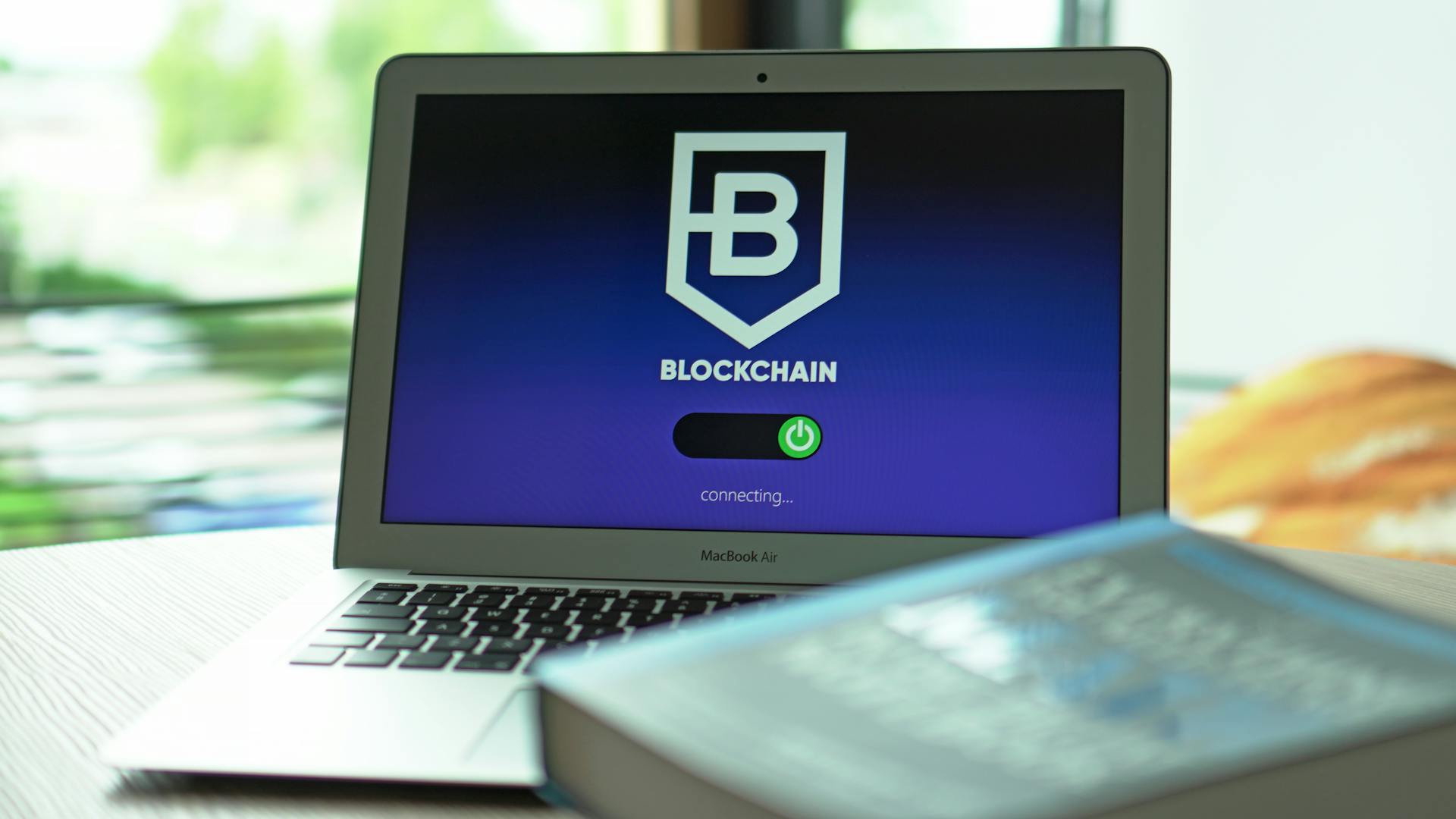
An air gapped crypto wallet is a physical device that stores your cryptocurrency private keys offline, completely disconnected from the internet. This provides an additional layer of security against hacking and cyber attacks.
Air gapped wallets are designed to be isolated from the internet, which makes them virtually unhackable. They use a combination of physical and digital security measures to protect your funds.
One of the most significant benefits of air gapped wallets is their ability to protect against phishing attacks, which are a common way for hackers to steal cryptocurrency. By keeping your wallet offline, you eliminate the risk of falling victim to phishing scams.
Air gapped wallets are not just for individuals; they're also used by organizations and institutions to store large amounts of cryptocurrency securely.
Suggestion: Crypto Wallet Security
What Is a Cold Wallet?
A cold wallet is essentially the same thing as an air-gapped wallet, and it's a device or system that generates and stores the private keys required to access your cryptocurrencies offline.
It's typically a hardware device or a specialized computer that remains disconnected from the internet, ensuring that your private keys cannot be compromised through online vulnerabilities.
This offline storage method sets cold wallets apart from their hot wallet counterparts, which are connected to the internet and therefore more susceptible to cyber attacks.
Air-gapped wallets, or cold wallets, have scannable QR codes, and some have a tiny micro-SD card for storing transaction history that has occurred on the crypto wallet.
By keeping your private keys offline, these wallets provide a formidable defense mechanism that shields your assets from potential cyber risks.
These wallets are a type of hardware wallet — physical devices — but not all hardware wallets are air-gapped wallets.
Here's an interesting read: How Does a Cold Wallet Work
Types of Cryptocurrency Wallets
Cryptocurrency wallets can be categorized into two main types: custodial and non-custodial wallets. Custodial wallets, like Binance and Kraken, manage your cryptocurrency and store your private key on your behalf, but this means you lack control over your funds.
Related reading: Best Custodial Crypto Wallet
Non-custodial wallets, on the other hand, grant users control over their private keys, making them responsible for signing and validating transactions. These wallets are typically decentralized and include options like Trust Wallet and Ledger Nano S Plus.
Custodial wallets often have user-friendly designs and recoverable accounts, while non-custodial wallets have simpler interfaces that may require some technical know-how. If you lose your private keys with a non-custodial wallet, there's no way to access your accounts.
There are three subcategories of wallets: software wallets, hardware wallets, and paper wallets. Software wallets are run on computers or mobile devices, hardware wallets are physical devices designed for storing private keys offline, and paper wallets are physical documents containing your private keys.
Air-gapped wallets fall into one of these subsets, and there are three broad categories of air-gapped crypto wallets. These include air-gapped hardware wallets, air-gapped computer wallets, and air-gapped smartphone wallets.
Here's a breakdown of the three types of air-gapped crypto wallets:
Hardware Wallets
To create an air gapped wallet, you'll need a dedicated hardware device such as a hardware wallet or a Raspberry Pi.
A hardware wallet is a great option, but make sure you choose one from a trusted manufacturer to ensure security.
You can also use a separate computer, but be aware that this may compromise the air gapped aspect of your wallet.
A hardware wallet will provide an additional layer of security for your air gapped wallet, keeping your private keys safe from unauthorized access.
When selecting a hardware wallet, ensure it's compatible with your chosen software, which can be obtained from the wallet manufacturer's official website.
The official website is the best place to download the software, as it minimizes the risk of tampering or malware.
Consider reading: Ledger - Nano S plus Crypto Hardware Wallet
How It Works
Air-gapped crypto wallets operate through computer-based software, connected to the wallet's QR code or micro-SD card. This software uses partially signed transactions, such as Partially Signed Bitcoin Transactions (PSBTs) for Bitcoin and Partially Signed Ethereum Transactions (PSETs) for Ethereum.
Discover more: Hardware Wallet vs Software Wallet
To perform a Bitcoin transaction, you create a PSBT using a Bitcoin wallet, then export it to your air-gapped wallet. The transaction is then signed using the private keys of your air-gapped wallet.
The offline signing process is a crucial aspect of air-gapped wallets. By storing private keys in an offline environment, you prevent exposure to online threats.
Here's a step-by-step overview of a typical air-gapped crypto wallet transaction:
- Create a PSBT using a Bitcoin wallet.
- Export the PSBT to your air-gapped wallet (either using a Micro SD card or by scanning a QR code).
- Sign the transaction using the private keys of your air-gapped wallet.
- Export the transaction back into your original Bitcoin wallet (either by scanning a QR code or by putting the Micro SD card back into the first wallet).
- Broadcast the transaction to the blockchain after confirming the transaction on the original wallet.
The first device remains entirely offline, storing the private keys essential for authorizing transactions. Due to its complete separation from the internet, this device ensures the security of private keys, making it resistant to hacking attempts.
You might enjoy: Private Crypto Wallet
Security Features
Air-gapped crypto wallets are a game-changer when it comes to security. They're not connected to the internet, making them immune to attacks and reducing the risk of hacking, phishing, malware, and network vulnerabilities.
By keeping your private keys offline, you eliminate the risk of online attacks and hacking attempts, allowing you to carry out cryptocurrency transactions with peace of mind. This added layer of security ensures that your digital assets remain under your control and are shielded from potential threats.
Air-gapped wallets provide an extra level of security by requiring physical access to the device holding the private keys. This means that even if a cybercriminal manages to infiltrate your online systems, they would still need physical access to the offline device to compromise your funds.
Private keys stored exclusively in the air-gapped wallet reduce the risk of theft significantly.
Broaden your view: Air Conditioning
Setup and Maintenance
Setting up an air gapped wallet is a straightforward process that involves acquiring the necessary equipment and software, and following the manufacturer's instructions to set up the hardware or computer as an air gapped environment.
To maintain your air gapped wallet, remember to keep your device disconnected from the internet at all times to maintain its security. This is crucial to ensure your wallet remains secure.
You'll need to follow a series of steps to set up your air gapped wallet, including installing the wallet software, generating your private keys, and configuring the wallet settings per your preferences.
The setup process requires technical know-how, which can be a disadvantage for those who may not have that ability.
Having successfully set up your air gapped wallet, you'll have total control of your digital assets, giving you an increased level of autonomy consistent with the cryptocurrencies' decentralized nature.
To maintain and make transactions with your air gapped wallet, you'll need to follow a specific process, which we'll explore further in this article.
Here's a step-by-step guide to setting up your air gapped wallet:
- Acquire the necessary equipment and software.
- Follow the manufacturer's instructions to set up the hardware or computer as an air gapped environment.
- Install the wallet software on the air gapped device.
- Generate your private keys and securely store them offline.
- Configure the wallet settings per your preferences.
Benefits and Drawbacks
Air-gapped crypto wallets offer enhanced security, making them a popular choice for storing cryptocurrencies. The primary advantage of air-gapped wallets is the enhanced security they bring.
The benefits of using air-gapped wallets include the ability to disconnect from the internet, which reduces the risk of hacking and malware attacks. This is particularly useful for storing large amounts of cryptocurrency. Despite their advantages, air-gapped wallets also have their drawbacks.
Security Risks and Precautions
Air gapped wallets eliminate the risk of online attacks and hacking attempts by keeping your private keys offline. This added layer of security ensures that your digital assets remain under your control.
By requiring physical access to the device holding the private keys, air gapped wallets add another dimension of protection to your cryptocurrency holdings, making it significantly harder for malicious actors to breach your defenses.
Cons
Air-gapped wallets may seem like a secure option, but they have their drawbacks. One of the main cons is limited accessibility.
Users lack direct access to trade stored crypto assets, making it difficult for those who need to make frequent transactions. This can be a significant drawback for active traders or investors.
Air-gapped wallets are disconnected from the internet and external devices, which helps protect them from hackers. However, this isolation also means users can't easily access their assets when they need to.
This lack of accessibility can lead to inconvenience and frustration for users who rely on quick transactions. It's essential to weigh the benefits of air-gapped wallets against the potential drawbacks.
See what others are reading: Do I Need a Coinbase Wallet to Send Crypto
Preventing Unauthorized Access
Air-gapped wallets provide a high level of security by keeping your private keys offline, eliminating the risk of online attacks and hacking attempts.
This added layer of security ensures that your digital assets remain under your control and are shielded from potential threats. By keeping your private keys offline, you eliminate the risk of online attacks and hacking attempts.
Air gapped wallets require physical access to the device holding the private keys, adding another dimension of protection to your cryptocurrency holdings. This physical barrier makes it significantly harder for malicious actors to breach your defenses.
As long as you keep your air gapped device offline and follow recommended security practices, the chances of compromise are extremely low. While no system is completely immune to potential vulnerabilities, air gapped wallets significantly reduce the risk of hacking.
Air gapped wallets prevent unauthorized access to your cryptocurrencies, making them inaccessible to hackers. This level of protection is particularly crucial in an environment where cybercriminals are constantly evolving their techniques to exploit vulnerabilities in online systems.
To further enhance security, always double-check the recipient's address for accuracy, verify the transaction details, including the amount and fees, and sign transactions offline and broadcast them securely using a trusted internet-connected device.
Here's an interesting read: Online Wallet
Frequently Asked Questions
Is AirGap wallet safe?
AirGap wallet is generally considered secure, but it's not foolproof and requires high user responsibility. While it protects against malware and hackers, it's still vulnerable to user error and other security risks.
Is Ledger Nano air-gapped?
The Ledger Nano X is not a traditional air-gapped device, but it uses a secure chip to store private keys offline, protecting them from internet threats. This unique approach provides a high level of security for your cryptocurrencies.
Featured Images: pexels.com


